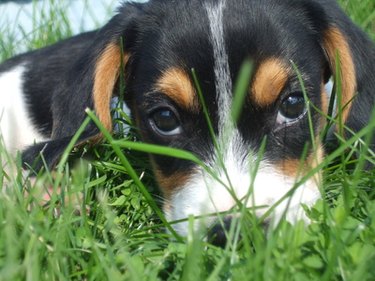
A canine spay is when the uterus and ovaries are surgically removed from your female dog, which is also called an ovariohysterectomy. This is performed prior to your puppy's first heat cycle, most commonly at six months of age. Veterinarians can chose to spay earlier, at six to 16 weeks old in some situations. Spaying has many health benefits for your dog, including prevention of cancer and pyometra, an infection in which when the uterus becomes full of pus and cannot drain. Pet owners also play a large part in their dog's spay and can ensure a successful, healthy recovery though attentive monitoring and care.
Surgery Day
Video of the Day
Your dog may not have anything to eat after midnight the night before surgery. Do not allow full-on trips to the water bowl during this time, but a few sips administered by the pet owner are okay. On the day of surgery, drop her off at the animal hospital in the early morning. The staff will explain the steps of the procedure with you, and ask for a phone number to call you after surgery completion.
Video of the Day
Hospital Discharge
Once the surgery is completed and your dog is in recovery, the veterinarian's office staff will call you with an update and provide a time when you can pick her up to go home. A veterinarian technician will fit your dog with an Elizabethan collar, also called an E-collar. The E-collar prevents your dog from licking or biting at the surgical incision. The veterinarian will send your dog home on pain medications and antibiotics to prevent any infections. The veterinarian will also go over any take-home instructions, medication dosing instructions, and schedule a follow-up appointment for suture removal.
At Home
Not all dogs will respond to surgery in the same way. Some may act completely fine as though nothing has happened, and others may be sleepy and less energetic as they recover. Keep a close eye on your pet and confine them to a small area to ensure they do not move around too much. Give them blankets or a soft dog bed to lie on. Do not let them jump up to or down from furniture, or go up or down flights of stairs because these movements can tear the suture site. Look at the incision site daily, checking for any oozing, swelling, bleeding or odd smells. If you find any of these symptoms, call your veterinarian immediately as this may indicate an infection.
Eating and Behavior
Slowly re-introduce water to your dog, or give them ice cubes. The anesthesia can cause nausea and vomiting, and your dog may be disinterested in eating food for a day or two after surgery. If a healthy appetite does not return, report this to your veterinarian. Your dog may also have throat irritation from the breathing tube used during surgery, and may experience coughing. Keep small children away from the pet during this initial recovery period, as your dog may be irritable or sensitive to any stimulation.
Recovery Period
The entire recovery period lasts for 10 to 14 days. Your dog should return to their normal behavior within a 24 to 48 hour period. After 10 to 14 days have passed, the veterinarian will remove your dog's sutures and reinspect the incision site to ensure its proper healing. After a thorough examination, the veterinarian will approve your dog to resume all normal activity.
Always check with your veterinarian before changing your pet’s diet, medication, or physical activity routines. This information is not a substitute for a vet’s opinion.